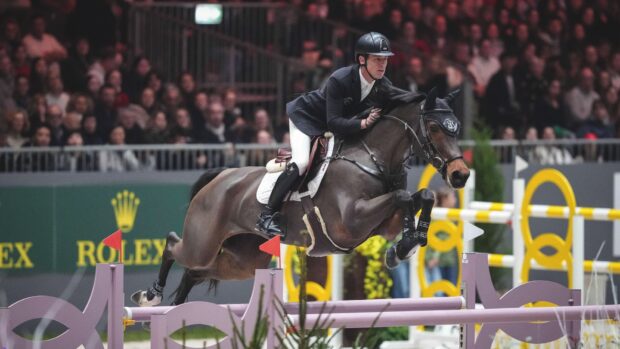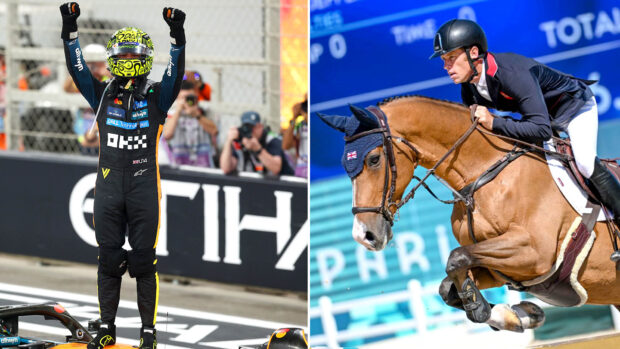“People are fascinated with the gimmick and the ‘quick fix’. It’s always been like that,” says George Morris, combining both resignation and disapproval in his statement.
“But, as a foundation,” he emphasises, “you can’t beat classical truisms that have stood the test of time.”
This philosophy is the cornerstone of Morris’s teaching methods, whether he is working with aspiring junior riders or the old pros who have “been there and done that”.
Melanie Smith Taylor, one of his most ardent disciples, sums up his methods this way: “He keeps it simple and does not over-train. He keeps the horses fresh and the riders confident.”
Melanie, a 1984 Olympic team gold medallist, now retired from riding and working as a TV commentator on equestrian sports, notes that: “Under George’s tutelage, I always felt that I could jump any course anywhere in the world ¨ and win, if it was my day. There is no one I would rather walk the course with or have setting jumps for me and being by my side than George.”
George says that, while he prefers to keep things “as simple, natural and classic as possible”, he does warn. “From that, you sometimes have to deviate and try different bits and things like that. But those little departures are not the foundation of training of the horse.”
He likes to see horses started in a snaffle for flatwork.
“I work all my horses in plain snaffles,” says George, who utilises side-reins only for lungeing and has little use for draw reins.
“I don’t think that’s how you hold a horse together,” he explains. “You put him together with your leg through your hands, not hands alone.”
George no longer teaches hunter seat equitation, that American discipline for junior riders judged on form, but its influence remains. His riders are never sloppy in their posture and tend to look neat in the saddle, even over the biggest grand prix course.
Most of his lessons offer an equal balance of time on the flat and over fences, contrary to the procedures of many trainers, who give flatwork short shrift and concentrate on jumping.
While his mentor, formerUS Equestrian Team (USET) coach Bertalan de Nemethy was a proponent of cavaletti, Morris does not use the method to quite the same extent.
“I use cavaletti, but not as much as Bert; his whole system came off cavaletti,” says George. “I also like to go more directly into canter. I trot to fences, but not as much as Bert. Sometimes, we would hardly canter to a fence before the first show in Europe on a tour.”
Anyone who learns from Morris has to get used to doing a lotmore than basic walk, trot and canter, however.
“I emphasise shoulder-in, haunches-in and the half-pass. That automatically collects, connects and engages the horse; it puts the horse into the rider’s legs and hands,” he points out.
Students often find themselves standing on the ground and watching George ride their horse, demonstrating how to do things correctly. He has also written two books. The classic Hunter Seat Equitation is in its third edition, while The American Jumping Style analyses what it takes to win in the toughest competitions.
Although George has mellowed slightly over the years, he is still a stern taskmaster who knows what he wants and has no time for those who are not serious about trying to become better riders.
“They do it my way or they don’t come back,” he says of the people who literally line up for his group lessons and clinics. “I have a short fuse when they’re not paying attention.”
He also lacks patience with those who don’t want to spend time on their riding.
“More than anything,” says former World Cup champion Leslie Burr Howard, “George gave me a great work ethic. No day was too long. Nobody works harder than George. If youcan keep up with him, you’re doing well.”
George believes that “early to rise” is a key to success, along with physical fitness. He combines the two, often getting up at 4:45am to go to the gym before travelling to his stables.
He wants to see riders trim, and has commented to that effect many times, injuring the feelings of the overweight along the way.
Tact often falls by the wayside with George Morris, because he will use whatever method required to get his riders to focus.
Leslie Burr Howard, who used to have a problem remembering courses, recalls that, after one instance of forgetfulness in the ring, George “chased me back to the barn with a bullwhip. Luckily,” she adds with a smile, “I was a little faster than him.”
When he is dealing with talent facing a real problem, however, George is patient and will do whatever is necessary to accomplish a goal.
With Leslie, he finally figured out that she should memorise the course by learning the colours of the jumps in sequence ¨ and it worked.
Despite what is often perceived as brusqueness, George knows how to relate to people.
“He’s always had a terrific following and a great clientele,” saysLeslie.
Norman Dello Joio, the 1992 individual Olympic bronze medallist, notes that George is good at “reading” what riders and horses need, and finding a way for them to do their best together.
George studies the great ridersand is a keen observer of what makes them tick.
“I like the way John Whitaker does it; he rides with a forward seat,” says George. “Ludger Beerbaum became more classical by watching the Americans and the greatest stylist today is Thierry Pomel. The French invented style.”
He has great admiration for both Nelson Pessoa and his son, three-times World Cup champion and reigning World Champion, Rodrigo.
“Rodrigo was born with a silver spoon in his mouth and he knows what to do with it,” says George. “Everything he and his father do is classical.”
George shares the USET chef d’equipe’s job in an unusual arrangement with Frank Chapot, his team-mate on the silver medal squad from the 1960 Rome Olympics. But it works well.
“He’s more of a public person, I’m more private,” says Chapot, who concentrates more on the technical aspects, while Morris coaches.
“Perseverance is his strong point. He can do it all day, week-in and week-out.
“After Thanksgiving, he’s on the road for the whole month, giving clinics all over the country. He has always been very serious about the sport.”


